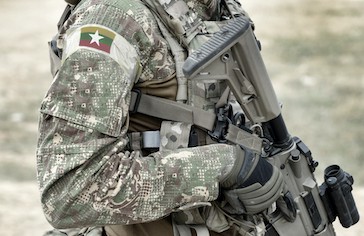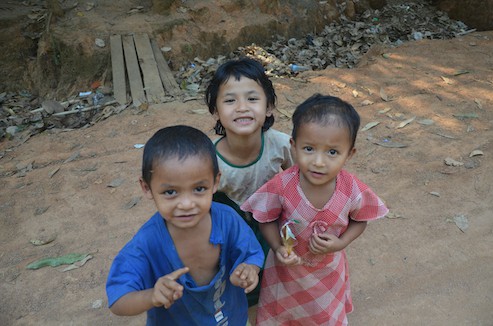William Faulkner wrote, “"The past is never dead. It's not even past." Faulkner’s aphorism sums up well the challenges that Burma – now known as Myanmar - faces as it struggles to escape the legacy of the past. The 2021 military coup d’état that overthrew the government of Aung San Suu Kyi is the latest episode in a complex and sometimes violent history that continues to shape Burma’s contemporary political environment.
Thant Myint U, a prominent Burmese historian and commentator, contends that “Burma has been molded by big forces and big issues.” [1]
Three issues and forces in particular have dominated Burmese politics and society before and since independence in 1948, namely: Burma’s diverse ethnic and religious topography; the role of the armed forces (or the “Tatmadaw” in Burmese) in national governance; and the contours of Burma’s political economy.
The Conundrum of Diversity
Thant observes that, “As it is today, Burma was likely a hodgepodge of very different cultures and communities.” The “hodgepodge” is the result of past Burmese conquests, immigration and colonization.
British colonization in the early 19th Century, amplified the challenges of diversity. Colonial administrators sought to counter-balance the most powerful indigenous community – the Buddhist Bamah of lowland Burma. Thus “Non-Burmans were often recruited into the colonial civil service and army and were sometimes used to put down Burman resistance movements.”
Colonialism also imposed a racial and exclusionary hierarchy (trenchantly portrayed in George Orwell’s novel, Burmese Days [2]) that further fragmented Burmese society.
Burma’s entanglement in World War II deepened these divides. Britain and Japan armed ethnic groups loyal to their cause, and as the war ended, these wartime rivalries and mistrust erupted into bloody violence.
In 1947 General Aung San (father of Aung San Suu Kyi) negotiated Burma’s independence. The ethnic minorities were not included in those negotiations, but he later forged an agreement (at the Panglong Conference), which accorded “full autonomy” to several (but not all) of the ethnic groups. [3]
We cannot know if Aung San would have pursued a long-term policy of inclusion: a few months after the Panglong Conference, he was assassinated.
On taking office six decades later, Aung San Su Kyi launched the Union Peace Conference (UPC) – 21st Century Panglong, echoing her father’s pre-independence initiative.
The Tatmadaw was skeptical of the UPC process. The army chief, Senior General Min Aung Hlaing called the demands of ethnic armed groups “unrealistic”, describing them as “far beyond the federal system.” Despite this skepticism, a framework for further negotiations was agreed when the UPC sessions adjourned in 2020 ahead of national elections.
The UPC did not tackle the communal troubles in Rakhine State. There, an armed irredentist movement, and the Buddhist majority’s antipathy to the Muslim minority (known as the Rohingya), created a highly volatile situation.
Aung San Suu Kyi enlisted Kofi Annan to chair a commission to advise on measures to address these tensions. The commission’s final report called for an end to discrimination against the Rohingya, but also highlighted local grievances – chronic poverty, the paucity of economic and educational opportunity, and the perceived indifference of the central government to local needs.
Annan urged the government to move quickly to deal with the crisis in Rakhine before it became untenable. Tragically, that warning proved prescient. The day the Commission’s report was published, the Arakan Rohingya Salvation Army (ARSA) attacked police posts in northern Rakhine, triggering a murderous retaliation by the Tatmadaw. In a matter of weeks, some 745,000 Rohingya fled to Bangladesh.
To the dismay of her many admirers, Aung San Suu Kyi defended the Tatmadaw, claiming that the genocide assertion was “factually misleading.”
While the international community deplored Suu Kyi’s support for the Tatmadaw, her stance was not unpopular among the Bamah population, largely antipathetic to the Rohingya. In September 2021, Suu Kyi’s party, the National League for Democracy (NLD) won a resounding victory in the national elections.
Martyrdom, Myth and Militarism
Commenting on British colonization, Myint Thant noted that “the modern state of Burma was born as a military occupation.”[4] Ironically, since independence, Burma has largely remained under military occupation, but the occupiers have been the Burmese military.

The Burmese military has fostered the myth that it is the heir to Aung San’s struggle for independence and national sovereignty, claiming legitimacy from that association.
At independence Burma became a parliamentary democracy, but the military still exercised a powerful influence. In 1962, General Ne Win, a close associate of Aung San, staged a coup and abolished parliamentary government, ushering in 26 years of dictatorship marked by widespread human rights abuses, suppression of minorities, and a form of economic autarchy masquerading as socialism.
A student uprising in 1988 precipitated a coup that ended Ne Win’s reign. Aung San Suu Kyi, who had just returned to Burma, called for the restoration of democracy, and quickly became the symbol and leader of the pro-democracy movement.
Aung San Suu Kyi’s extraordinary story of endurance under house arrest and imprisonment is well known. After the NLD won the 2015 general elections she was appointed State Counsellor, a device that enabled her to become the president in all but name.
Nonetheless, the Tatmadaw still did not concede full political control. The 2008 constitution effectively allows the military to block constitutional amendments. Moreover, the key security ministries and agencies are headed by serving military officers; military promotions and budget matters are largely self-regulated.
In effect, the military has functioned as a state within a state.
The NLD’s huge victory in the 2020 elections, and the prospect of constitutional change, clearly alarmed the Tatmadaw. Despite Aung San Su Kyi’s earlier support for the military during the Rakhine crisis, the Tatmadaw high command was not willing to accept the new order. To their surprise, however, the coup precipitated a popular uprising.
Ironically, the military intervention has managed to achieve what Aung Suu Kyi could not: a unity of purpose across the political, demographic and ethnic divides.
Extraction and Exploitation: Power and the Political Economy
Under colonialism, Burma’s largely subsistence economy was transformed into an extractive juggernaut based on cash crops (at one point, Burma accounted for roughly half of global rice exports) and natural resource extraction.
However, during his rule Ne Win radically altered the political economy. His “Burmese Way to Socialism” isolated the country from international trade and cooperation,[5] and placed much of the economy under state control.
In those days travelling from Bangkok to Rangoon (now Yangon) was a step back in time. The quiet, rural streets of Rangoon, with their array of vintage cars and trucks – many of them relics of WWII – contrasted sharply with the bustle of Bangkok.
After Ne Win’s fall in 1988, the Tatmadaw began to liberalize the economy. In 1997 Burma joined the Association of Southeast Asian Nations (ASEAN) to stimulate inward investment and trade.[6] Economic growth did indeed rebound, but the military with its business allies at home and abroad, acquired huge stakes in the reviving Burmese economy. Unfortunately, “cronyism and racketeering thrived,” as did the trafficking of natural resources with the collusion of the military, ethnic groups, and neighbouring states.[7]

Since the coup, strikes, civil disobedience, and a burgeoning insurgency have precipitated an economic free-fall. According to the UN Development Programme, nearly half of the population in Burma will be living in poverty this year, “roughly double the number from five years ago.”
So where does Burma go from here?
The international community has responded to the coup with mixed messages. By and large democratic states have denounced the military takeover, but major powers like China, Russia and India have not publicly condemned the coup. ASEAN initially dithered with a split between the democratic-leaning members and those adopting a sovereigntist, hands-off approach.
ASEAN and the UN have nominated special envoys for Burma but so far they have gained little traction.
Neither side seems ready for compromise or mediation.
As Richard Horsey of the International Crisis Group points out, the Tatmadaw is “now locked into a spiraling crisis, deploying extreme violence to try to ensure the survival of their regime,” believing that “military might and counter-insurgency experience will allow them to prevail in the end.” The Tatmadaw plans to hold new elections in 2023, but Horsey rightly cautions that those “polls would be a flashpoint for dissent and unrest, not a step toward stability.”
For its part, the opposition will not countenance any external intervention that may lend legitimacy to the coup. Local resistance forces and the National Unity Government (NUG) are determined to pursue confrontation, so violence will continue.
Serious negotiations on the future of the country most likely will have to await the outcome of the military confrontation. Only then perhaps will attention return to resolving the paradox that has bedeviled Burma since independence: it is a union without unity.
Several incompatibilities make the quest for unity in Burma a uniquely difficult proposition.
The first is the civilian and military competition for executive power. The military portrays itself as the guardian of national sovereignty against ethnic secession and foreign incursion. But it has become an adversary to much of the Burmese population, including the Bamah of lowland Burma. The military must redefine its mission in a modern Burma.
This has happened elsewhere in countries like Indonesia, as well as in Latin America, where a generation ago most countries were under military rule.
Second, the vision and construct of a multiethnic state has to be defined and agreed in a consensual manner and entrenched in a constitutional settlement. However, this issue is not only about the minorities versus the central government; the minorities have conflicts among themselves that also must be addressed.
Finally, the political economy of Burma has to evolve towards a balanced model that does not exploit the vulnerable and appropriate the wealth of the country for the benefit of a few. The extractive model has remained a constant in the Burmese political economy, but that must change if Burma is to reach levels of human development comparable with its ASEAN peers.
The NUG and former parliament members have already made proposals for a Federal Democracy Charter, as well as interim constitutional arrangements, which can “bring an end to the conflicts and problematic root causes in the Union” and “ensure all ethnic nationalities – population can participate and collaborate and to build a prosperous Federal Democracy Union where all citizens can live peacefully.” They propose to convene constitutional convention to develop and validate a new constitution.
The National Unity Consultative Council (NUCC), which regroups opponents of the regime is endeavouring to promote a dialogue on the way forward although it remains to be seen if it will fall prey to the fractious divides that have doomed earlier attempts at national dialogue.
As always, the devil will be in the detail. And while external partners can share experiences from constitutional innovations from other states experiencing violent internal conflict, such innovations must be pioneered by Burmese actors at local and national levels. Imposed, top-down solutions will not work.
A great crisis can also bring great opportunity. Burma’s current crisis, tragic though it is, nevertheless brings with it the promise of a better future, provided that the people of Burma are encouraged and allowed to seize that opportunity.
[1] Thant Myint-U, The Hidden History of Burma: Race, Capitalism and the Crisis of Democracy in the 21st Century, Atlantic Books, London, 2019.
[2] George Orwell, Burmese Days, Harper & Brothers, New York, 1934.
[3] Matthew J Walton, “Ethnicity, Conflict, and History in Burma: The Myths of Panglong,” Asian Survey, Volume 48, Issue 6, University of California Press, December 2008.
[4] Ibid Thant
[5] Kenton Clymer, A Delicate Relationship, Cornell University Press, 2016.
[6] Robert Cribb, “Burma’s entry into ASEAN: Background and Implications,” Asian Perspective. Vol. 22, No. 3, John Hopkins University Press, 1998: https://www.jstor.org/stable/4270418
[7] Ibid Thant


